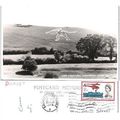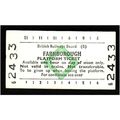Cerne Abbas, Dorset - Cerne Giant - RP Judges postcard 1963
- Condition : Used
- Dispatch : 2 Days
- Brand : None
- ID# : 106620668
- Quantity : 1 item
- Views : 513
- Location : United Kingdom

- Seller : justthebook (+1703)
- Barcode : None
- Start : Wed 22 May 2013 23:11:15 (BST)
- Close : Run Until Sold
- Remain : Run Until Sold
More Listings from This Seller view all
Seller's Description
- Postcard
- Picture / Image: Cerne Giant - Cernes Abbas, Dorset - real photo type
- Publisher: Judges of Hastings
- Postally used: yes
- Stamp: 2&half d. Lifeboats commemorative
- Postmark(s): Bournemouth & Poole 25 Aug 1963 wavy line
- Sent to: Main Street, Cambridge
- Notes / condition:
Please ask if you need any other information and I will do the best I can to answer.
------------------------------------------------
Postage & Packing:
UK (incl. IOM, CI & BFPO): 99p
Europe: £1.60
Rest of world (inc. USA etc): £2.75
No additional charges for more than one postcard. You can buy as many postcards from me as you like and you will just pay the fee above once. (If buying postcards with other things such as books, please contact or wait for invoice before paying).
Payment Methods:
UK - PayPal, Cheque (from UK bank) or postal order
Outside UK: PayPal ONLY (unless otherwise stated) please. NO non-UK currency checks or money orders (sorry).
NOTE: All postcards are sent in brand new stiffened envelopes which I have bought for the task. These are specially made to protect postcards and you may be able to re-use them. In addition there are other costs to sending so the above charge is not just for the stamp!
I will give a full refund if you are not fully satisfied with the postcard.
----------------------------------------------
Text from the free encyclopedia WIKIPEDIA may appear below to give a little background information (internal links may not work) :
*************
The Cerne Abbas Giant is a hill figure near the village of Cerne Abbas in Dorset, England. Made by a turf-cut outline filled with chalk, it depicts a large, naked man, typically described as a giant, wielding a club. The figure is listed as a scheduled monument in the United Kingdom and the site where he stands is owned by the National Trust.
The figure has been the subject of much study and speculation, but its origin and age are unclear. It is often thought of as an ancient construction, though the earliest mention of it dates to the late 17th century. Early antiquarians associated it, on little evidence, with a Saxon deity, while other scholars sought to identify it with a Celtic British figure or the Roman Hercules, or some syncretization of the two. Archaeological evidence that parts of the drawing have been lost over time strengthen the Hercules identification. However the lack of earlier descriptions leads modern scholars to conclude that it may date from the 17th century, and perhaps originated as political satire.
Regardless of its age, the Cerne Abbas Giant has become an important part of local culture and folklore, which often associates it with fertility. It is one of England's best known hill figures and is a major visitor attraction in the region.
The Cerne Abbas Giant is located just outside the small village of Cerne Abbas in Dorset, about 30 mi (48 km) west of Bournemouth and 16 mi (26 km) north of Weymouth. The figure depicts a huge naked man, about 180 ft (55 m) high and 167 ft (51 m) wide. It is carved into the white chalk rock [2] on the steep west-facing side of a hill known as Giant Hill[3] or Trendle Hill.[4][5] Atop the hill is another landmark, the Iron Age earthwork known as the ""Trendle"" or ""Frying Pan"".[6] The carving is formed by outlines cut into the turf about 2 ft 0 in (0.6 m) deep, and filled with crushed chalk.[3] In his right hand the giant holds a knobbled club 120 ft (37 m) in length,[7] and adding 35 ft (11 m) to the total height of the figure.[2] A line across the waist is considered to be a belt.[8] Writing in 1901 in the Proceedings of the Dorset Natural History and Archaeological Society, Henry Colley March noted that: ""The Cerne Giant presents five characteristics: (1) It is petrographic ... It is, therefore, a rock carving ... (2) It is colossal ... (3) It is nude. ... (4) It is ithyphallic ... (5) The Giant is clavigerous. It bears a weapon in its right hand.""[9]
A 1996 study found that some features have changed over time, concluding that the figure originally held a cloak in its left arm and stood over a disembodied head.[10] The former presence of a cloak was corroborated in 2008 when a team of archaeologists using special equipment determined that part of the carving had been allowed to be obliterated. The cloak may have been a depiction of an animal skin, giving credence to the theory that the giant was a depiction of a hunter, or alternatively, Hercules with the skin of the Nemean lion over his arm.[11] Additionally, reviewing historical depictions of the giant, it has been suggested that the Giant's current large erection is, in fact, the result of merging a circle representing his navel with a smaller penis during a re-cut.[12] In 1993, the National Trust gave the Giant a ""nose job"" after years of erosion had worn it away.[13][14]
The Giant has been described as ""renowned for its manhood"",[15] ""markedly phallic"",[2] ""sexually explicit""[16] and ""ithyphallic"".[17] The Giant sports an erection, including its testicles, some 36 feet (11 metres) long, and nearly the length of its head.[18] It has been called ""Britain's most famous phallus"".[19] One commentator noted that postcards of the Giant were the only indecent photographs that could be sent through the English Post Office.[20]
The carving is most commonly known as the Cerne Abbas Giant.[21][22][23][24] The National Trust and others call it the ""Cerne Giant"",[21][25] while English Heritage and Dorset County Council call it simply ""The Giant"".[26][27] The carving has also been referred to as the ""Old Man"",[28] and more recently it has been referred to as the ""Rude Man"" of Cerne.[29][30]
Although the best view of the Giant is from the air, most tourist guides recommend a ground view from the ""Giant's View"" lay-by and car park off the A532.[31][32] This area was developed in 1979 in a joint project between the Dorset County Planning Department, the National Trust, Nature Conservancy Council (now called English Nature), the Dorset Naturalists Trusts, the Department of the Environment, and local land-owners. The information panel there was devised by the National Trust and Dorset County Council.[33]
Like several other chalk figures carved into the English countryside, the Cerne Abbas Giant is often thought of as an ancient creation. However, as with many of the other figures, its history cannot be traced back further than the late 17th century, making an origin during the Celtic, Roman or even Early Medieval periods difficult to demonstrate. Medieval sources do refer to the hill the giant is now on, calling it Trendle Hill - perhaps a reference to the nearby landmark known as the Trendle.[4][6] Joseph Bettey noted that none of the earlier sources for the area, including a detailed 1617 land survey, refer to the giant, suggesting that it may not have been there at the time.[34] In contrast, the Uffington White Horse has been shown to be 3,000 years old, and there are references to it, across the ages.[35]
The earliest known written reference to the giant is a 4 November 1694 entry in the Churchwardens' Accounts from St Mary's Church in Cerne Abbas, which reads ""for repairing ye Giant, 3 shillings"".[36][37] In 1734, The Bishop of Bristol noted and inquired about the giant during a visitation to Cerne Abbas. The bishop's account, as well as subsequent observations such as those of William Stukeley, were discussed at meetings of the Society of Antiquaries of London in 1764.[38][39] Additionally, in 1738 the antiquarian Francis Wise mentioned the giant in a letter.[40]
Beginning in 1763 descriptions of the giant appeared in contemporary magazines. The earliest known survey was published in the Royal Magazine in September 1763. Derivative versions subsequently appeared in the October 1763 St James Chronicle, the July 1764 Gentleman's Magazine,[41] and the 1764 edition of The Annual Register.[38][42][43][44][45] The Gentleman's Magazine account in particular was prominent, and contained the oldest known drawing of the figure.[38][41] In 1774, the antiquarian John Hutchins reviewed various previous accounts in his book The History and Antiquities of the County of Dorset.[38] In it, he wrote that the carving had only been done the previous century.[6]
The earliest known drawing of the Giant appears in the August 1764 issue of Gentleman's Magazine.[41] A map referred to as the ""1768 Survey Map of Cerne Abbas by Benjamin Pryce"" is held at the Dorset History Centre.[46] However, a record at the National Archives notes that ""the cartouche refers to Lord Rivers by that title which he did not acquire until 1776. Numbers on the map appear to correspond with the survey of 1798""[47]
type=real photographic (rp)
theme=topographical: british
sub-theme=england
county/ country=dorset
number of items=single
period=1945 - present
postage condition=posted
Listing Information
| Listing Type | Gallery Listing |
| Listing ID# | 106620668 |
| Start Time | Wed 22 May 2013 23:11:15 (BST) |
| Close Time | Run Until Sold |
| Starting Bid | Fixed Price (no bidding) |
| Item Condition | Used |
| Bids | 0 |
| Views | 513 |
| Dispatch Time | 2 Days |
| Quantity | 1 |
| Location | United Kingdom |
| Auto Extend | No |



 for 1 item(s)
for 1 item(s)















